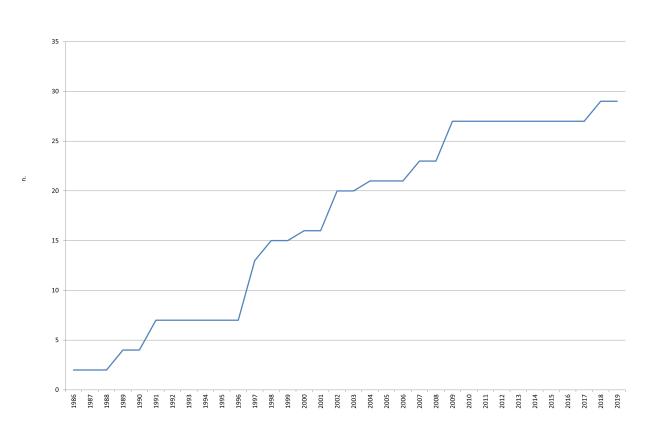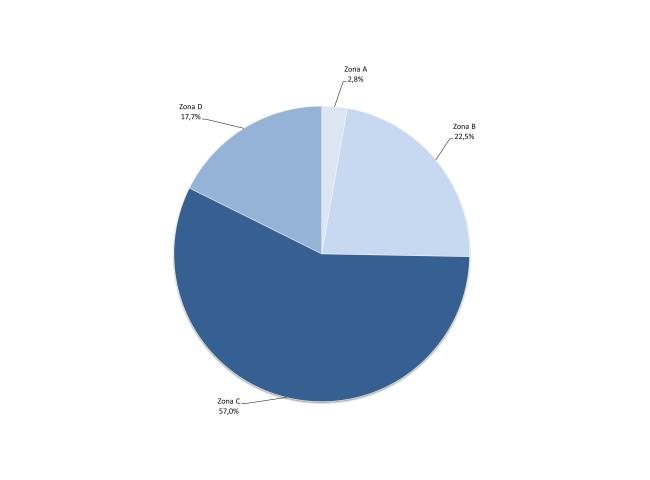Panel 1
Susanna D'Antoni, Stefania Ercole, Luisa Nazzini, Silvia Properzi
The number of areas and the extent of protected marine surface have steadily increased over time. Currently, Italy has 39 Marine Protected Areas (MPAs), established in 10 Italian regions; of these, 29 are Marine Protected Areas (AMPs). Sicily and Sardinia are the regions with the highest number of marine protected areas, both in terms of quantity and protected marine surface.
Between 2012 and 2019, the national surface area of MPAs increased by 1.9%, thanks to the establishment in 2018 of two Marine Protected Areas: Capo Testa - Punta Falcone in Sardinia and Capo Milazzo in Sicily.
The indicator describes the surface of Italian coastal waters under a protection regime. Specifically, the indicator considers water falling within Marine Protected Areas (AMPs, established under Laws 979/1982 and 394/1991 and subsequent amendments) and other types of protected areas listed in the Official List of Protected Areas (EUAP). All these areas are collectively referred to under the indicator as "Marine Protected Areas" (MPAs). The Marine Natural Area of International Interest represented by the "Sanctuary for Marine Mammals" is not included in the surface area calculation.
To assess the level of marine environment protection by measuring the surface area of Italian coastal waters included in Marine Protected Areas (AMPs) established under Laws 979/1982 and 394/1991 and subsequent amendments, as well as other types of protected areas listed in the Official List of Protected Areas (EUAP) with protected marine surfaces.
L 979/82 (Disposizioni per la difesa del mare);
L 127/85 (Ratifica ed esecuzione del Protocollo relativo alle aree specialmente protette del Mediterraneo);
L 394/91 (Legge Quadro sulle Aree Protette) e s.m.i.;
EUAP, VI agg. (DM 27.04.2010 GU n. 125 del 31.05.2010);
DM 17/05/2018, n. 102. Istituzione dell'area marina protetta «Capo Testa - Punta Falcone»;
DM 26/11/ 2018, n. 153. Approvazione del regolamento di disciplina dell’area marina protetta «Capo Milazzo» (pubblicato in GU n. 55 del 6-3-2019).
Panel 2
EUAP, VI agg. (DM 27.04.2010 GU n. 125 del 31.05.2010)
The indicator provides quantitative information only, without assessing the implementation status, effectiveness of protection, or environmental conditions of the protected areas.
-
Data quality assessment
MATTM (Ministry of the Environment and Protection of Land and Sea)
Consultation of the Official List of Protected Areas (EUAP) published in the Official Journal;
Consultation of the Common Database on Designated Areas (CDDA) published on the website of the European Environment Agency.
National, Regional (10/20)
1986-2019
Indicator assessment
The collected data were presented in tabular and graphical form through digital processing. The temporal increase in the number of Marine Protected Areas (MPAs) established was calculated based on the date of signature of the first establishment decree.
-
The trend can be considered positive as both the number and surface area of marine protected areas (MPAs) have steadily increased over time. Between 2012 and 2019, the total national MPA surface area increased by 1.9%, thanks to the establishment of two new Marine Protected Areas in 2018: Capo Testa - Punta Falcone in Sardinia and Capo Milazzo in Sicily.
Data
Tabella 1: Superficie delle Aree Protette Marine per regione e tipologia di area protetta
Elaborazione ISPRA su dati MATT - V EUAP (2003); MATTM - VI EUAP (2010) e MATTM (2012 e sett. 2019)
AANPN: Altre Aree Naturali Protette Nazionali ; AANPR: Altre Aree Naturali Protette Regionali ; AMP: Aree Marine Protette ; PN: Parchi Nazionali ; RNR: Riserve Naturali Regionali
Figura 2: Ripartizione percentuale della superficie delle Aree Marine Protette secondo i livelli di zonazione
Elaborazione ISPRA su dati MATTM
Zona A , di riserva integrale, interdetta a tutte le attività che possano arrecare danno o disturbo all'ambiente marino. In tale zona sono consentite in genere unicamente le attività di ricerca scientifica e le attività di servizio. Zona B, di riserva generale, dove sono consentite, spesso regolamentate e autorizzate dall'organismo di gestione, una serie di attività che, pur concedendo una fruizione ed uso sostenibile dell'ambiente, determinano un impatto minimo. Zona C, rappresenta la fascia tampone tra le zone di maggior valore naturalistico e i settori esterni all'area marina protetta, dove sono consentite e regolamentate dall'organismo di gestione, oltre a quanto già consentito nelle altre zone, le attività di fruizione ed uso sostenibile del mare di modesto impatto ambientale. Zona D, presente solo in rari casi, prevede una regolamentazione meno restrittiva rispetto agli altri livelli di zonazione.


Sicily and Sardinia are the regions with the highest number of MPAs, both in terms of number (7 in Sicily and 7 in Sardinia) and protected marine surface area (79,895 ha in Sicily and 89,983 ha in Sardinia, including the marine area of the La Maddalena Archipelago National Park). Additionally, two MPAs in these regions were recently established: Capo Milazzo in Sicily and Capo Testa - Punta Falcone in Sardinia (established by decrees in 2018). In Campania, the six MPAs cover a total area of 22,441 ha. In Lazio, the five MPAs span a total of 4,204 ha, significantly smaller compared to the previously mentioned regions, as three of these areas have a very limited extent (less than 10 ha). Conversely, in Tuscany, the sole presence of the Tuscan Archipelago National Park protects an area of nearly 57,000 hectares (Table 1).
However, the surface area alone does not determine the actual level of protection, which is closely linked to the zoning regulations within each area. As shown in Figure 2, only 2.8% of the total MPA surface area is under strict protection (Zone A), while the remaining surface areas allow regulated human activities aligned with conservation objectives (Zones B, C, and D). Zone D, where restrictive measures are minimal, is present only in the MPAs of "Isole Egadi," "Regno di Nettuno," and "Torre del Cerrano," but accounts for 17.7% of the total MPA surface area.
As seen in Figure 1, the number of MPAs increased modestly until the mid-1990s, after which there was a stronger push for their establishment. Since 2009, the trend has stabilized, with the only major increase occurring in 2018 with the designation of two new MPAs.